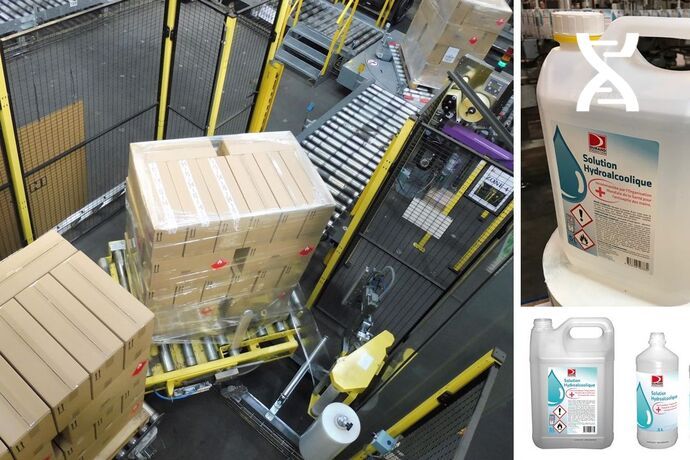Best practices in inventory management in the Covid era
The evolution of inventory management scenarios
The logistics sector has always been in constant evolution, across the entire supply chain from upstream to downstream, right down to the last mile. Despite the major uncertainties linked in particular to the health crisis that the entire planet has been undergoing since 2020, we can bet on future major transformations according to two scenarios. On the one hand, we can assume that globalization will continue at a moderate but steady pace. Or, on the other hand, that a downturn will occur, due to the free-trade system being called into question and/or a worsening of the climate and environmental crisis. In either case, the logistics sector will adapt and restructure accordingly. Before turning to inventory management as such, let's take a look at the major market trends that are emerging If we are betting on a further increase in world trade, which is the preferred hypothesis of contemporary analysts, the rise in transport costs for environmental reasons will be felt in the short term.
Adapting inventory management to actual customer demand
At the other end of the supply chain, we are also witnessing spectacular changes, notably in the final delivery sector, which has undergone several (r)evolutions, from just-in-time distribution to instant delivery. Optimizing final delivery has been a major trend over the last two decades, mainly due to different production and consumption patterns. Transport accounts for around 20% of the price of a good, and the last kilometer of delivery for almost 28% of the price of transport, which clearly demonstrates the stakes involved.
As a result, we're seeing the emergence of delivery bays designed for crossdocking (i.e., without warehousing time), efforts to rationalize regional logistics in major conurbations, the proliferation of relay points in all urban, suburban and even rural areas, and so on. These logistics systems are about to undergo profound transformations under the dual impact of digitization and environmental challenges.
Fluidity in stock circulation
Let's not forget that poor inventory management exposes a company to major risks, and can even jeopardize its future. For example, under-stocking can result in production stoppages, or in unavailable items, which is highly detrimental to consumer loyalty. Over-stocking, on the other hand, entails high storage and logistics costs, and can lead to product obsolescence, especially if the products are perishable. Optimal inventory management is therefore a guarantee of a company's structural health We are now witnessing the development of just-in-time distribution, or what is also known as "zero stock", which is gradually taking the place of in-store warehousing, multiplying delivery movements. With the exponential growth of e-commerce, we are also seeing a parallel dispersion of transport flows carried out by small vehicles. The fierce competition for ever-faster delivery times (24 hours, 2 hours) demanded by end customers now determines purchasing choices, and instant delivery has become the model to follow. E-commerce will continue its ascent until connected commerce becomes widespread, even for short or local circuits, which have been boosted by the health crisis and forced to adapt to the digital age in order to survive and remain sustainable. At company level, this requires almost instantaneous reactivity in stock management, in order to respond effectively to these new demands.
The health crisis has also been a decisive factor in the success of click and collect models, i.e. the collection of parcels and purchases from local shops, particularly in France As a result, we need to determine how best to adapt inventory management, which has a direct impact on the company's cash flow, to these fluctuating needs. Poor management immediately translates into higher logistics costs, and a stock shortage leads to an irreversible loss of market share. Depending on the two constant factors of time and quantity, there are 4 different management methods: the calendar method, where the manager orders a fixed quantity on a fixed date; the order point method, where a certain stock level triggers replenishment; the replenishment method, with a fixed date for replenishment according to consumption; and finally, order-based replenishment, where all parameters are variable and controlled according to demand. Good inventory management therefore implies a perfect understanding of variable factors, but above all the ability to adapt to them rapidly for optimum responsiveness.
The challenges and trends thus revealed can be summed up in five points:
- Job growth in last-mile logistics, with uberization and optimization of van load factors.
- Renewal of the road haulage workforce, with driverless trucks soon to be put on the road in automated platoons (also known as Platooning), linked by wifi to reduce costs and improve safety, security and traceability.
- The reduction of handling through robotization and automation of warehouses, which is already well underway in this sector, involving the development and exploitation of high technologies;
- The growth of jobs linked to the port sector (containers, etc.) with the development of smart ports, which are automated ports using technology such as IoT (the Internet of Things or connected structures), blockchain solutions (unforgeable data control) or artificial intelligence to enhance economic performance and competitiveness;
- Finally, the strong growth in skilled jobs for the digitization of logistics processes.
Indeed, logistics 4.0 is inventory management based on IT connectivity, the digitization of information and the use of outsourced services in the cloud. As a reminder, logistics 2.0 and 3.0 are more focused on robotization and standardization of procedures, which are unavoidable with the growing development of global trade
As far as pooling is concerned, this would be a major asset in gaining competitive advantages. Large companies have already begun this process, and the vast SME sector promises great potential. These are strategies for pooling resources between service providers, manufacturers and distributors. We'll be seeing large-scale containerization of goods, with exhaustive traceability, the presence of the Internet at every level of the supply chain, and automation at virtually every link; which also implies the parallel development of cutting-edge technologies.
Ensuring greater fluidity in the flow of inventory, without compromising operating costs or the environment, will be a real challenge for all players in the logistics sector over the next few years. The health crisis since 2020 has highlighted these inventory management and logistical challenges, which were hardly visible before.






